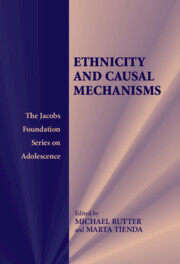Book contents
- Frontmatter
- Contents
- List of Contributors
- Foreword
- Preface
- 1 Natural Experiments, Causal Influences, and Policy Development
- 2 Growing Up Ethnic in the United Kingdom and the United States: Comparative Contexts for Youth Development
- 3 The Multiple Facets of Ethnicity
- 4 Educational Attainments: Ethnic Differences in the United Kingdom
- 5 Race and Ethnic Inequality in Educational Attainment in the United States
- 6 Racial and Ethnic Disparities in Crime and Delinquency in the United States
- 7 Explaining Ethnic Variations in Crime and Antisocial Behavior in the United Kingdom
- 8 Cultural Differences in the Effects of Physical Punishment
- 9 Ethnicity and Mental Health: The Example of Schizophrenia in the African-Caribbean Population in Europe
- 10 Ethnic Variations in Youth Suicide
- 11 Ethnicity and Intergenerational Identities and Adaptations in Britain: The Socio-Political Context
- 12 Assimilation, Dissimilation, and Ethnic Identities: The Experience of Children of Immigrants in the United States
- 13 Deciphering Ethnicity: Reflections on Research Opportunities
- Author Index
- Subject Index
2 - Growing Up Ethnic in the United Kingdom and the United States: Comparative Contexts for Youth Development
Published online by Cambridge University Press: 05 July 2014
- Frontmatter
- Contents
- List of Contributors
- Foreword
- Preface
- 1 Natural Experiments, Causal Influences, and Policy Development
- 2 Growing Up Ethnic in the United Kingdom and the United States: Comparative Contexts for Youth Development
- 3 The Multiple Facets of Ethnicity
- 4 Educational Attainments: Ethnic Differences in the United Kingdom
- 5 Race and Ethnic Inequality in Educational Attainment in the United States
- 6 Racial and Ethnic Disparities in Crime and Delinquency in the United States
- 7 Explaining Ethnic Variations in Crime and Antisocial Behavior in the United Kingdom
- 8 Cultural Differences in the Effects of Physical Punishment
- 9 Ethnicity and Mental Health: The Example of Schizophrenia in the African-Caribbean Population in Europe
- 10 Ethnic Variations in Youth Suicide
- 11 Ethnicity and Intergenerational Identities and Adaptations in Britain: The Socio-Political Context
- 12 Assimilation, Dissimilation, and Ethnic Identities: The Experience of Children of Immigrants in the United States
- 13 Deciphering Ethnicity: Reflections on Research Opportunities
- Author Index
- Subject Index
Summary
Introduction
Understanding whether and how group membership influences adolescent behavior and a myriad of outcomes requires an appreciation of the social and economic arrangements in which youth forge their transition to adulthood. Because several chapters that follow involve paired comparisons of youth experiences in the United Kingdom and the United States, this chapter situates them in context by sketching a socio-demographic overview of youth in both countries. First, I provide the demographic sketch of both countries, focusing on how migration altered their ethnoracial landscapes. Subsequently, I characterize the current social and economic conditions of immigrant and minority youth, offering temporal perspectives as data permit.
This enterprise presumes the availability of comparable data over time, but this mere condition is seldom met. Not only do official classification systems evolve, but so also do the methods for collecting migration status and ethno-racial group membership. I briefly acknowledge these limitations and, perforce, limit cross-country comparisons to general overviews based on social and demographic indicators. To capitalize on the nuances of country-specific data, the social conditions of immigrant and minority youth are profiled separately, reserving for the conclusion a synthesis of key differences and similarities. My use of the phrase immigrant and minority youth is deliberate, to acknowledge that not all immigrant youth are members of minority populations and that groups designated as minorities are not necessarily foreign-born (although their parents or distant ancestors may be immigrants).
- Type
- Chapter
- Information
- Ethnicity and Causal Mechanisms , pp. 21 - 49Publisher: Cambridge University PressPrint publication year: 2005
- 2
- Cited by



